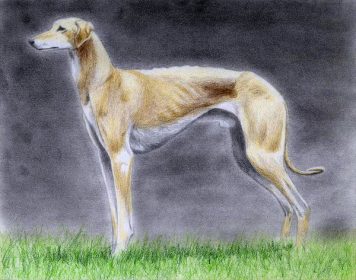
Cynologists believe that numerically, “desert dogs” are the largest group of dogs in the world, but because they’ve been shunned for so long in many parts of the world, often because of religious or cultural considerations, they have the fewest known and established breeds. They are, without doubt, however, among the most well adapted canines for their environment. A long and narrow head slices through desert winds while increasing the mechanics of cooling hot air in the nasal passages. Tall legs act like stilts to distance the torso from hot sand, and a deep chest increases lung capacity needed for a double suspension gallop and speed. Light bones enhance endurance, and a short coat that regulates temperature is typically the color of sand
The Sloughi of Morocco is a fine example of a “desert breed,” though the concept of “breeds” didn’t really exist in ancient times as much as “types” of dogs did. Certainly the Sloughi is quite old, having been mentioned in a 13th century book by the Moroccan writer Al Mansur, and seen in rock engravings that date to the Neolithic Period. It was also one of the few dogs that not only got a pass for being regarded as “unclean” by the Muslim faith, but was treated like a member of the family. New litters were cause for celebrations among friends, and when a Sloughi died, traditional funeral offerings such as sugar or a lamb were offered as solace for bereavement.
Though the breed is sometimes called the the Arabian Sighthound, this is wrong because it was the indigenous, nomadic Berbers (the Amazigh or “free people,” as they call themselves) who developed the breed long before the invasion of the Arabs. Locally, the breed is known as the Sloughi Moghrebi, or “Sighthound of the Maghreb.”
Image: Sloughi by Olde Time Mercantile is available as a poster, print and greeting card here.
